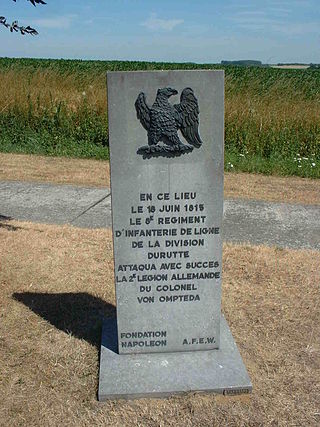A stele (plural steles or stelai) is a stone or wooden slab, generally taller than it is wide, erected as a monument, very often for funerary or commemorative purposes.
Contents
Stele may also refer to:
A stele (plural steles or stelai) is a stone or wooden slab, generally taller than it is wide, erected as a monument, very often for funerary or commemorative purposes.
Stele may also refer to:
Sargon may refer to:

György Kurtág is a Hungarian composer of contemporary classical music and pianist. According to Grove Music Online, with a style that draws on "Bartók, Webern and, to a lesser extent, Stravinsky, his work is characterized by compression in scale and forces, and by a particular immediacy of expression". In 2023 he was described as "one of the last living links to the defining postwar composers of the European avant-garde".

The Mesha Stele, also known as the Moabite Stone, is a stele dated around 840 BCE containing a significant Canaanite inscription in the name of King Mesha of Moab. Mesha tells how Chemosh, the god of Moab, had been angry with his people and had allowed them to be subjugated to the Kingdom of Israel, but at length, Chemosh returned and assisted Mesha to throw off the yoke of Israel and restore the lands of Moab. Mesha also describes his many building projects. It is written in a variant of the Phoenician alphabet, closely related to the Paleo-Hebrew script.
The Xi'an Stele or the Jingjiao Stele, sometimes translated as the "Nestorian Stele," is a Tang Chinese stele erected in 781 that documents 150 years of early Christianity in China. It is a limestone block 279 centimetres high with text in both Chinese and Syriac describing the existence of Christian communities in several cities in northern China. It reveals that the initial Church of the East had met recognition by the Tang Emperor Taizong, due to efforts of the Christian missionary Alopen in 635. According to the stele, Alopen and his fellow Syriac missionaries came to China from Daqin in the ninth year of Emperor Taizong (635), bringing sacred books and images. The Church of the East monk Adam composed the text on the stele. Buried in 845, probably during religious suppression, the stele was not rediscovered until 1625. It is now in the Stele Forest in Xi'an.

A stele, or occasionally stela when derived from Latin, is a stone or wooden slab, generally taller than it is wide, erected in the ancient world as a monument. The surface of the stele often has text, ornamentation, or both. These may be inscribed, carved in relief, or painted.
The Three Steles of Seth is a Sethian Gnostic text. It is the fifth tractate in Codex VII of the Nag Hammadi library. The writing is in Coptic and takes up the last nine pages of the codex.

The Stele of Ankh-ef-en-Khonsu is a painted, wooden offering stele located in Cairo, Egypt. It was discovered in 1858 by the French Egyptologist François Auguste Ferdinand Mariette at the mortuary temple of the 18th Dynasty Pharaoh Hatshepsut, located at Deir el-Bahari. It was originally made for the Montu-priest Ankh-ef-en-Khonsu i, and was discovered near his coffin ensemble of two sarcophagi and two anthropomorphic inner coffins. It dates to circa 680–70 BCE, the period of the late 25th Dynasty/early 26th Dynasty. Originally located in the former Boulaq Museum under inventory number 666, the stele was moved around 1902 to the newly opened Egyptian Museum of Cairo, where it remains today.

Sekhemre Wahkhau Rahotep was an Egyptian pharaoh who reigned during the Second Intermediate Period, when Egypt was ruled by multiple kings. The Egyptologists Kim Ryholt and Darrell Baker believe that Rahotep was the first king of the 17th Dynasty.

Hilarri is the name given to disk-shaped funerary steles that are typical of the Basque Country.

The Stele of Zakkur is a royal stele of King Zakkur of Hamath and Luhuti in the province Nuhašše of Syria, who ruled around 785 BC.

Shutruk-Nakhunte was king of Elam from about 1184 to 1155 BC, and the second king of the Shutrukid Dynasty.
Játékok is an ongoing collection of "pedagogical performance pieces" by György Kurtág. He has been writing them since 1973. Ten volumes had been published as of 2021. Volumes I, II, III, V, VI, VII, IX and X are for piano solo. Volumes IV and VIII are for piano 4-hands or two pianos.

The Victory Stele of Naram-Sin is a stele that dates to approximately 2254–2218 BC, in the time of the Akkadian Empire, and is now at the Louvre in Paris. The relief measures 200 cm. in height and was carved in pinkish sandstone, with cuneiform writings in Akkadian and Elamite. It depicts the King Naram-Sin of Akkad leading the Akkadian army to victory over the Lullubi, a mountain people from the Zagros Mountains.
Stele, Op. 33, sometimes also stylised in Greek capitals as ΣΤΉΛΗ, is a composition for orchestra by Hungarian composer György Kurtág. It was completed in 1994.
Armazi stele may refer to:
Zincirli stele usually refers to one of a number of steles found in the archaeological site of Zincirli:
In music, Op. 33 stands for Opus number 33. Compositions that are assigned this number include:

Márta Kurtág was a Hungarian classical pianist and academic piano teacher. She was the wife of György Kurtág, with whom she performed for 60 years, including at international festivals. They often played from his collection Játékok, which they also recorded together.

The Eight Great Events (ashtammaha-pratharya) are a set of episodes in the life of Gautama Buddha that by the time of the Pala Empire of North India around the 9th century had become established as the standard group of narrative scenes to encapsulate the Buddha's life and teachings. As such they were frequently represented in Buddhist art, either individually or as a group, and recounted and interpreted in Buddhist discourses.